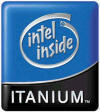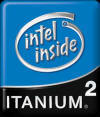
 |
Introduction date:
Frequency:
Category:
Transistors:
Power:
Data Bus:
Address Bus:
CACHE
L1 Cache:
L2 Cache:
L3 Cache:
History:
|
June 2001 (Itanium I)
July 2002 (Itanium II)
Itanium I : 667 - 800 MHz
Itanium II: 900 -1600 MHz
64 Bit Processor
Itanium II: 221.000.000 0,18 micron
130 Watt !! at 1,3 Volt
64 Bit
64 Bit
16+16 KB
256 KB
1,5 MB - 9 MB
The Itanium was no longer superior to contemporaneous RISC and
CISC processors. Itanium competed at the low-end (primarily
4-CPU and smaller systems) with servers based on x86 processors,
and at the high end with IBM's POWER architecture and Sun
Microsystems' SPARC architecture. Intel repositioned Itanium to
focus on high-end business and HPC computing, attempting to
duplicate x86's successful "horizontal" market. With
economies of scale fueled by its enormous installed base, x86
was the preeminent "horizontal" architecture in enterprise
computing. HP and Intel recognized that Itanium was not
competitive and replaced it with Itanium 2 a year later, as they
had planned. Only a few thousand of the original Itaniums were
sold, due to limited availability caused by poor yields,
relatively poor performance, and high cost.
|



